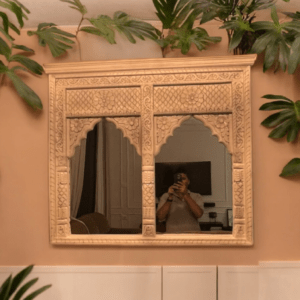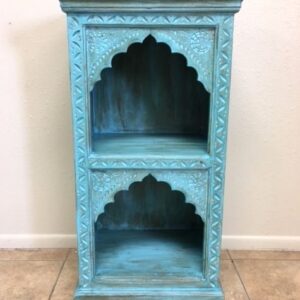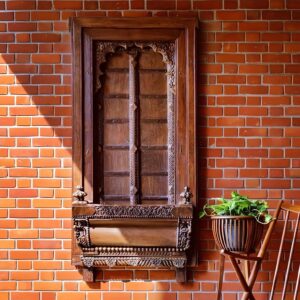Antique Jharokha Door: A Symbol of Historical Elegance and Architectural Beauty
The antique Jharokha door is a unique and striking element of traditional architecture, deeply rooted in the rich cultural heritage of regions like India. Jharokha, an overhanging enclosed balcony, is a term derived from Rajasthani architecture, and it typically features in palaces, forts, and havelis. Integrating a Jharokha into a door design creates a piece that is not just a functional entryway but also a work of art, embodying the opulence and craftsmanship of a bygone era.
Understanding the Jharokha Door
Historical Significance
Jharokha doors date back to ancient times and were prominent in the architecture of the Indian subcontinent, particularly in Rajasthan and Gujarat. They were often used in royal and noble residences, symbolizing status and luxury.
Design Elements
An antique Jharokha door is characterized by intricate carvings, ornate decorations, and often a blend of wood and metal. These doors often feature traditional motifs, floral patterns, and religious or cultural symbols.
Materials Used
Craftsmen traditionally used durable woods like teak or sheesham for Jharokha doors, which were sometimes adorned with brass or iron fittings. The wood was chosen for its longevity and ability to withstand the test of time.
Decorating with an Antique Jharokha Door
As a Statement Entrance
Moreover, An antique Jharokha door can serve as a grand entrance to a home or a specific room, instantly elevating the aesthetic appeal and creating a sense of intrigue and history.
Incorporating into Modern Decor
However, Mixing old with new, an antique Jharokha door can be integrated into a contemporary setting as a contrast piece, adding an eclectic and unique touch to modern interiors.
As a Decorative Element
Although, Apart from its functional use as a door, a Jharokha can also be repurposed as a piece of wall art, a headboard for a bed, or even as a decorative frame for mirrors or paintings.
Preserving an Antique Jharokha Door
Regular Maintenance
To maintain the beauty and integrity of an antique Jharokha door, regular dusting and occasional polishing with appropriate wood oils or waxes are recommended.
Protecting from Environmental Factors
These doors should be protected from excessive moisture and direct sunlight, which can cause warping or fading.
Professional Restoration
Although, If the door is significantly aged or damaged, it’s advisable to consult with a professional restorer who also with specializes in antique woodwork to preserve its historical value and aesthetic.
Conclusion
In brief, An antique Jharokha door is more than just an architectural element; it’s a piece of history that brings a sense of grandeur and timeless beauty to any space. Whether used in its traditional form or repurposed for modern interiors, it offers a unique way to incorporate historical elegance into contemporary living spaces. For those who appreciate the fusion of art, history, and architecture, an antique Jharokha door is a treasure worth cherishing.
FAQs on Antique Jharokha Doors
What is an antique Jharokha door?
An antique Jharokha door is a traditional architectural element from the Indian subcontinent, notably Rajasthan and Gujarat. It incorporates the design of a Jharokha – an overhanging enclosed balcony – into the structure of a door, often characterized by intricate carvings and historical artistry.
How old are antique Jharokha doors?
The age of antique Jharokha doors can vary significantly, but many are several centuries old. They originate from periods when such architectural features were commonplace in Indian palaces, forts, and havelis.
What materials are used in antique Jharokha doors?
These doors are typically made from durable woods like teak or sheesham. They may also feature metalwork, such as brass or iron fittings, which add to their ornamental value.
Can an antique Jharokha door be integrated into modern home decor?
Absolutely. An antique Jharokha door can be a stunning focal point in modern home decor, offering a striking contrast to contemporary elements and adding a unique, historical charm to the space.
What are common uses of Jharokha doors in contemporary interiors?
In modern interiors, Jharokha doors can be used as entrance doors, room dividers, headboards, or as unique wall art. They are versatile and can be repurposed in various creative ways.
How do I maintain an antique Jharokha door?
Regular dusting and occasional polishing with appropriate wood oils or waxes are recommended. It’s important to protect the door from environmental factors like moisture and direct sunlight to prevent damage.
What should I do if my Jharokha door needs repairs?
For repairs or restoration, it’s best to consult with a professional who specializes in antique woodwork. They will have the expertise to preserve the door’s historical value and aesthetic integrity.
Are Jharokha doors considered valuable?
Yes, due to their historical significance, craftsmanship, and uniqueness, antique Jharokha doors are often considered valuable, both monetarily and as collectible art pieces.
How do I authenticate an antique Jharokha door?
Authenticating an antique Jharokha door usually requires expertise in historical Indian architecture and antiques. Consult with an expert in Indian antiques or a reputable antique dealer to verify its authenticity.
Can a Jharokha door be custom-made to fit modern homes?
While you can have a Jharokha-style door custom-made, it won’t be an ‘antique’. However, craftsmen can replicate the style to create a new door that fits the dimensions and style requirements of modern homes while keeping the traditional design elements intact.
How can I source an authentic antique Jharokha door?
Antique Jharokha doors can be sourced from antique dealers, auctions, or stores specializing in Indian or Asian antiques. Online platforms may also list such items, but it’s important to verify their authenticity and condition before purchasing.
By incorporating an antique Jharokha door into your space, you not only add a striking design element but also bring a piece of history into your home, creating a unique and culturally rich atmosphere.












